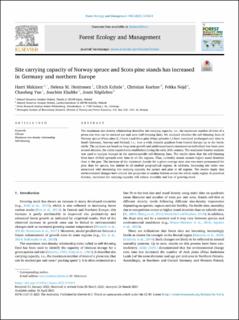| dc.contributor.author | Mäkinen, Harri | |
| dc.contributor.author | Henttonen, Helena | |
| dc.contributor.author | Kohnle, Ulrich | |
| dc.contributor.author | Kuehne, Christian | |
| dc.contributor.author | Nöjd, Pekka | |
| dc.contributor.author | Yue, Chaofang | |
| dc.contributor.author | Klädtke, Joachim | |
| dc.contributor.author | Siipilehtob, Jouni | |
| dc.date.accessioned | 2021-10-18T10:33:14Z | |
| dc.date.available | 2021-10-18T10:33:14Z | |
| dc.date.created | 2021-08-27T10:02:18Z | |
| dc.date.issued | 2021-04-10 | |
| dc.identifier.citation | Mäkinen, H., Henttonen, H. M., Kohnle, U., Kuehne, C., Nöjd, P., Yue, C., … Siipilehto, J. (2021). Site carrying capacity of Norway spruce and Scots pine stands has increased in Germany and northern Europe. Forest Ecology and Management, 492, 119214. | en_US |
| dc.identifier.issn | 0378-1127 | |
| dc.identifier.uri | https://hdl.handle.net/11250/2823646 | |
| dc.description.abstract | The maximum size-density relationship describes site carrying capacity, i.e., the maximum number of trees of a given size that can be stocked per unit area (self-thinning line). We analysed whether the self-thinning lines of Norway spruce (Picea abies (L.) Karst.) and Scots pine (Pinus sylvestris L.) have remained unchanged over time in South Germany, Norway and Finland, i.e., over a wide climatic gradient from Central Europe up to the Arctic circle. The analyses are based on long-term growth and yield experiments measured on individual tree basis over several decades, the oldest experiments established during the early 20th century. The stochastic frontier analysis was used to analyse changes in the species-specific self-thinning lines. The results show that the self-thinning lines have shifted upwards over time in all the regions. Thus, currently stands sustain higher stand densities than in the past. The increase of the maximum density for a given average stem size was more pronounced for pine than for spruce, but similar in all studied geographical regions. In addition, increasing site index was associated with increasing site carrying capacity for spruce and pine in all regions. The results imply that environmental changes have altered site properties in similar fashion across the whole study region. In practical forestry, increased site carrying capacity will reduce mortality and loss of growing stock. | en_US |
| dc.language.iso | eng | en_US |
| dc.publisher | Elsevier B.V. | en_US |
| dc.rights | Navngivelse 4.0 Internasjonal | * |
| dc.rights.uri | http://creativecommons.org/licenses/by/4.0/deed.no | * |
| dc.title | Site carrying capacity of Norway spruce and Scots pine stands has increased in Germany and northern Europe | en_US |
| dc.type | Peer reviewed | en_US |
| dc.type | Journal article | en_US |
| dc.description.version | publishedVersion | en_US |
| dc.rights.holder | © 2021 The Author(s) | en_US |
| dc.source.volume | 492 | en_US |
| dc.source.journal | Forest Ecology and Management | en_US |
| dc.identifier.doi | 10.1016/j.foreco.2021.119214 | |
| dc.identifier.cristin | 1929186 | |
| dc.source.articlenumber | 119214 | en_US |
| cristin.ispublished | true | |
| cristin.fulltext | original | |
| cristin.qualitycode | 2 | |

